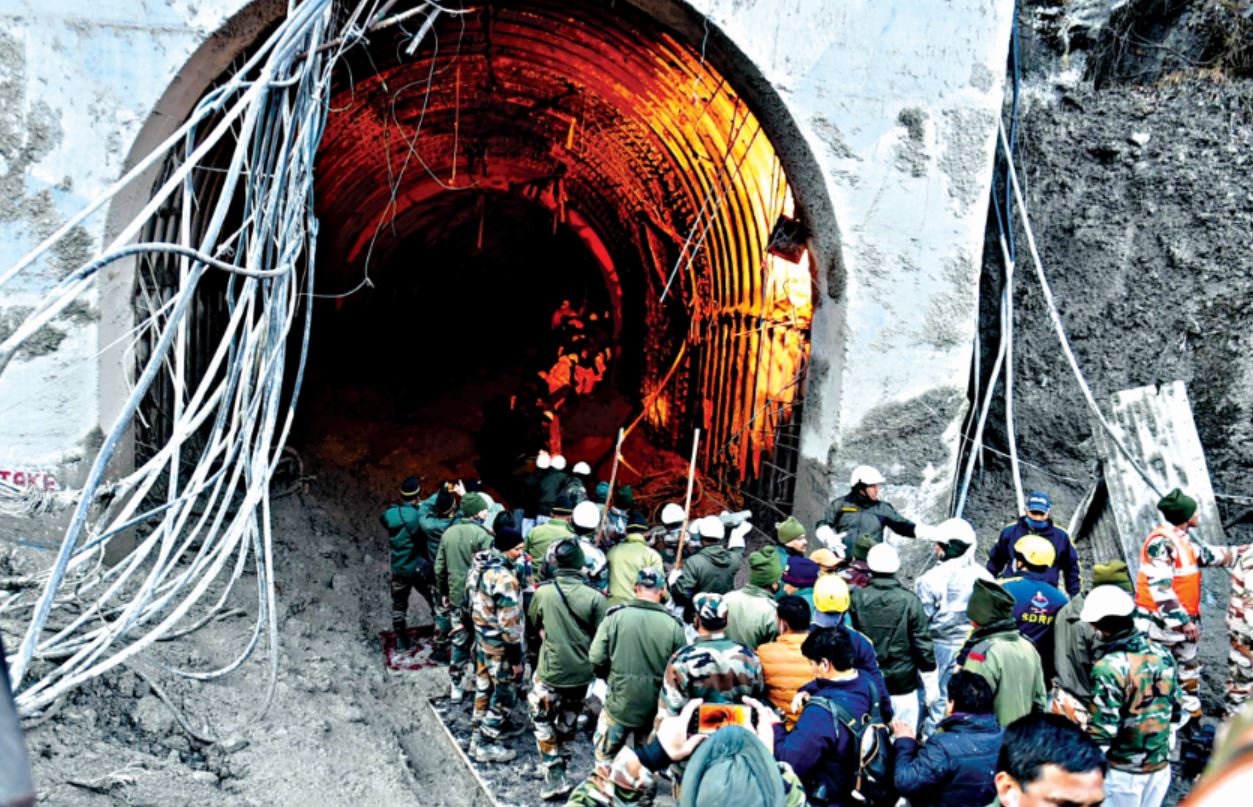 The devastation after the glacier burst in Nanda Devi mountain range in Tapovan region of Chamoli district of Uttarakhand, feared dead more than two hundred missing people. It came as an aftermath of ignoring warnings of expert committees constituted for environmental impact assessment of various power and road development projects including ambitious Char-Dham Road Project of BJP government. Playing with nature besides global warming created havoc on even those poor people, who faced wrath of the local administration for protesting against illegal blasting in the area and slapped with charges of breaching peace and harmony on a complaint of Rishi Ganga project authorities.
The devastation after the glacier burst in Nanda Devi mountain range in Tapovan region of Chamoli district of Uttarakhand, feared dead more than two hundred missing people. It came as an aftermath of ignoring warnings of expert committees constituted for environmental impact assessment of various power and road development projects including ambitious Char-Dham Road Project of BJP government. Playing with nature besides global warming created havoc on even those poor people, who faced wrath of the local administration for protesting against illegal blasting in the area and slapped with charges of breaching peace and harmony on a complaint of Rishi Ganga project authorities.
The recent flash floods have swept away two hydropower projects in its way 13.2 MW project on Rishiganga river followed by 520 MW Tapovan project on Dhauliganga river from where more than 200 innocent labourers went missing and climatic conditions do not suggest possibilities of their survival, while many others got trapped in sudden mishap. The rescue teams of ITBP, NDFR and SDRF launched massive search operations to locate survivors after the tragedy.
The rescue forces recovered about 38 bodies from various locations where the flood inflicted huge destruction of life and properties. A glacial break in the Tapovan-Raini area led to massive flooding in Dhauli Ganga and Alaknanda Rivers, damaging houses and the nearby Rishiganga power project. Officials said rescue operations centered on a 1,900- metre-long tunnel at NTPC’s Tapovan site, where at least 200 people are believed to be trapped. Uttar Pradesh Relief Commissioner Sanjay Goyal confirmed 70 people from Uttar Pradesh are feared missing in the mishap including 34 from Lakhimpur Kheri, nine from Saharanpur and five from Shravasti districts who were engaged at project sites.
The former member of Block Development Committee of the worst-hit Raini village, Sangram Singh alleged, while talking to Tehelka, “The villagers protested explosive blasting at project site despite prohibition orders from the High Court. The careless damage to the trees at the foothills of Nanda Devi Reserve near notified core and buffer zones perhaps attributed as significant factor causing the tragedy. They alleged connivance of local administration behind clandestine support to illegal mining. “The effect of blast resulted in damage to wild life as many animals including dears found dead in the reservoir of the power plant. Their bodies were sent to Joshimath for autopsy but forest officers never told us about its outcome,” Sangram Singh added.
 “The Rishi Ganga Power project authorities put a stone crusher plant just 5-7 meter away from the river basin in violation of environmental norms and pushed away its rubbish material into the river stream that jammed the downstream tunnels,” alleged Kundan Singh on whose PIL High Court banned use of explosives in the power project. The villagers of Raini alleged illegal mining of stone and unlawful sale of material was being carried on in violation of law. They also approached Uttarakhand High Court through Public Interest Petition apprehending major tragedy due to violation of environmental norms of Himalaya range. The concerns rose in PIL proved true but efforts to save recurrence of disaster had gone waste.
“The Rishi Ganga Power project authorities put a stone crusher plant just 5-7 meter away from the river basin in violation of environmental norms and pushed away its rubbish material into the river stream that jammed the downstream tunnels,” alleged Kundan Singh on whose PIL High Court banned use of explosives in the power project. The villagers of Raini alleged illegal mining of stone and unlawful sale of material was being carried on in violation of law. They also approached Uttarakhand High Court through Public Interest Petition apprehending major tragedy due to violation of environmental norms of Himalaya range. The concerns rose in PIL proved true but efforts to save recurrence of disaster had gone waste.
The shocking news of abrupt collapse of under-construction bridge of BRO close to the Indo-Tibet border just after 2 days of Uttarakhand added further miseries to panic affected areas from the point of view of strategic defence concerns where three labours died and nine are missing. Raini village is worst affected area from where road connectivity for Indo-Tibet border had completely cutoff due to damage of motor road bridge besides six-seven swing bridges catering light traffic damaged in the floods which connect around 15-20 villages from the main road.
Satellite images depict that a huge slice of the glacier dislodged by a landslide produced roaring torrents in the Rishiganga and Dhauliganga rivers in Chamoli district, trapping unsuspecting workers at Rishi Ganga and Tapovan hydropower project sites. Hundreds of people are still missing in the force of wave of water, silt and debris that flooded the rivers and filled tunnels in the Tapovan power project.
It is unfortunate that the government did not understand the sensitivity and seriousness of the recommendations given by environmental assessment expert groups and committees constituted by apex court to examine the impact of development on overall ecology of Himalayan range where the geological reports highlighted cracks in mountain range calling for urgency to save ecology.
Expressing his dismay over the state of affairs in wake of earlier Kedarnath devastation, senior activist of Uttarakhand movement and Editor of Nainital Samachar Rajiv Lochan Shah said, “the government did not take the lesson from past experiences and allowed construction activities at the cost of compromises with ecological balance. Had it not
been a Sunday and during the day hours, the quantum of disaster could be bigger.” “The landslides in Uttarakhand Himalaya range are not a new phenomenon. Our concerns over such devastation continue from ages but the voices of wisdom go unheard in the race for development, he added in his recent article appeared in news portal Media Swaraj.”
The apex court constituted high power committee headed by Eminent environmental expert Dr Ravi Chopra of the People’s Science Institute in wake of Kedarnath calamity with an aim to study the role of hydropower projects in the disaster looking into geological sensitivity and fragility of mountain range. The Kedarnath tragedy damaged hydropower projects in Mandakini basin that actually restricted the natural flow of the river at high altitudes. The Committee opined, where valleys are 2000 meter above the sea level would come under sensitive category in para glacial zone of high Himalayas. The para-glacial zone is a deadly combination of snow, water and ice that wreaks everything in its path. The committee recommended suspending 23 out of 24 projects coming in risk zone. No one can deny that the tragedy could be averted had its recommendations been implemented.
“The Rishi Ganga Project suffered the similar setback in 2016 but it restarted construction and came into controversy for using explosives and stone crushers,” Shah revealed. The tragedy could be averted had the landslide not hit this project area above Raini village where mining material of crushed stones accelerated damaging intensity of flood water that damaged 7 km away Tapovan Hydropower project of NTPC from where maximum causalities are reported.
“It was wrong decision putting aside all norms to build hydropower project on Rishiganga river looking into its unique characteristics and source of appearance from the most dangerous Rishi George, one of the deepest in the world. The government declared Nanda Devi as a prohibited national sanctuary in 1982 where no man can enter in the core zone in order to preserve and protect its biodiversity, wild life, flora and fauna. The UNESCO has declared the Nanda Devi and Valley of Flowers National Parks as World Heritage Site in 1988. The river passes through peaks of Nanda Devi sanctuary from an altitude of 24600 feet to 19700 with steep slope making it fastest flowing river of Uttrakhand,” said Govind Pant Raju who is an avid mountaineer and the only Indian journalist to go to Antarctica expedition.
Raju revealed that this river gave warning against lopsided planning against environmental interference and washed away 13.2 MW Rishi
Ganga hydropower project in 2016 and the Ludhiyana based company become insolvent due to devastation. “Our rulers despite such severe warnings did not learn any lesson and allowed another Kundan group in 2018 to rebuild it,” He added while sharing his perception about the human tragedy with Tehelka.
“Uttarakhand Chief Minister Trivendra Singh Rawat had forgotten to console the people of the area who suffered loss of their lives and property, but his sympathies for the losses to the developer of the project were quite visible on his face during an interview to a news channel,” Raju candidly commented over his reaction over such a grave tragedy of such magnitude. “He even does not know the responsibility to construct road and bridges in the territorial areas had been a job of Boarder Road organisation and state’s Public Work Department has nothing to do with the damaged motor road bridge,” he added mentioning about his tweet wherein he appealed the people that they should not make this incident propaganda against development.
Unfortunately, this grave tragedy happened in the area known for epicenter leading “Chipko” movement of environmentalism led by Sunderlal Bahuguna, Gaura Devi against deforestation for construction of dams and power plants spoiling the ecological balance of the nature. The deep valleys along the rivers have attracted many private players for constructing hydroelectric projects and dams, with little concern for earthquake risk. Many disasters and human tragedies sent warning signals against indiscriminate exploitation of natural habitat after the earthquake in 1991 in the region where the Tehri dam was built and the 2013 floods that devastated Kedarnath washed away many neighbouring villages and population killing countless people.
The apprehensions of more disasters of this kind can happen in near future due unplanned development activities in the fragile geologically dynamic hilly region. Glaciologists have forecasted collapse of more glaciers, particularly nine kilometers long ‘Shila Samudra’ glacier where some little spots detected earlier turned large which may cause heavy destructions across the Mandakini riverbed in Chamoli district may flood Nand Prayag, Kanol until Hardwar. This glacier is popular among tourists for tracking but danger loom large over it due to cracks noticed in its range and even any landslides, earthquake may tiger big human tragedy.
Recent environmental studies at Dehradun-based Wadia Institute of Himalayan Geology warned Himalayan glaciers melting. Scientists on Uttarakhand glacier burst revealed that the glaciers in Nanda Devi and central Himalayan region have significantly receded during the past four decades. Glaciers and snowmelt in the Himalayan ecosystem are the source of water for several rivers across the subcontinent, and are responsible for maintaining the perpetual source of water supply in the river systems like the Indus, Ganges, and Brahmaputra to over a billion people. But these glaciers have reduced considerably in mass and surface area since the little ice age period. Global temperatures began to rise after 1850.
HC had banned mining in power project area
 The division bench of Uttarakhand High Court, headed by Chief Justice Ramesh Ranganathan and Justice Alok Kumar Verma, had prohibited use of explosive in any form in and around Raini village and Valley of flowers except with the prior written approval of the District Magistrate Chamoli and on the license being granted by competent authority under Explosive Act.
The division bench of Uttarakhand High Court, headed by Chief Justice Ramesh Ranganathan and Justice Alok Kumar Verma, had prohibited use of explosive in any form in and around Raini village and Valley of flowers except with the prior written approval of the District Magistrate Chamoli and on the license being granted by competent authority under Explosive Act.
The court also directed the District Magistrate to prevent any form of illegal mining in the area except with the prior written approval of the District Magistrate Chamoli and on the license being granted by competent authority under Explosive Act. The court also directed the District Magistrate to prevent any form of illegal mining in the area.
Raini village comes under the Nanda Devi Biosphere Reserve in the close proximity to the Indo-China border having very limited connectivity and public amenities. The court passed these orders after lengthy hearing on a Public Interest Litigation filed by Kundan Singh on behalf of residents of Raini village of Joshimath under district Chamoli on 26 June 2019. Most resident of Raini village comes from the scheduled Tribes category and has no definite source of income and earn livelihood by agricultural activities such as cultivation of Rajma and Koda. In order to support the present litigation, several villagers have contributed an amount each.
The petitioner is a resident of Smt. Gaura Devi village- A woman who is world renowned for the Chipko movement that she launched for the cause of environmental protection. Raini village is located near the Nanda Devi Biosphere Reserve and in close proximity to the “Valley of Flowers,” alleging that illegal mining activities are being carried on by, and in the name of, Rishi Ganga Power Project; and substantial damage has been, and is being, caused as a result thereof to this village and its surroundings.
The photographs, enclosed along with the Writ Petition, indicate substantial damage having been caused to the area, and do lend credence to the submission that explosives are being used for illegal mining.
Petitioner’s counsels Sandeep Kothari and Abhijay Negi, learned argued that the very fact that the Power Corporation had sought, and had obtained, permission from the District Administration, to extract and transport river bed material, would support that gave foundation to the petitioner’s claim of illegal mining being resorted to in the area.
The PIL stated that resort to explosives that too for carrying on illegal mining operations, may well result in destruction of the Nanda Devi Biosphere Reserve, and the Valley of Flowers which is located nearby.
The counsel for Rishi Sagar Power Project Naman Kamboj denied the allegation and stated that they have not resorted to any form of illegal activities, and are not using explosives.
The court directed the Member Secretary, Uttarakhand State Pollution Control Board and the District Magistrate, Chamoli to constitute a joint inspection team to cause a physical inspection of the area to assess the extent of environmental damage caused and ascertain whether illegal mining operations carried on using explosives for the said purpose. The court asked to place a comprehensive report before it at the earliest and, in any event, within two weeks from today.
Illegal blasting activities at the base of glacier blamed
Abhijay Negi recalls the first words of villagers from devastated Raini village, how haplessly with moist eyes they urged, “Saheb Hamara Pahad Gir Jayega, Isko Rokiye, (Our hills will fall down stop it).”
Negi is a practicing young and energetic pro-bono human rights lawyer, who drafted and filed Public Interest Litigation in 2019 for these poor persons, who were struggling for their rehabilitation of livelihood and protection of environment from the threat of devastation due to reckless unlawful use of explosives for illegal mining in the catchment area of Rishi Ganga where a private entrepreneur is constructing 13 MW Rishi Ganga Power Project.
“The first impression of their perception proved them right besides other environmental concerns as well such as about this controversial Rishi Ganga Power Project Company which allegedly indulged in blasting activities just at the base of the glacier and therefore Uttarakhand High Court had put a stay order on the blasting. The Power project company also hoodwinked the villagers with false promise of employment, jobs, but gave them nothing,” told Negi while sharing tale of woes of justice seeker poor villagers with “Tehelka.”
“The villagers approached me after collecting small contribution of 50-100 from their scheduled tribe community to reach my office in Nainital. Frankly, it is very difficult to come from such remote areas where they live near Nanda Devi Biosphere Reserve in very difficult living conditions. They came to me from very far away place to Nainital for filing a public interest petition,” he added.
The villagers alleged in their PIL that their traditional approaching forest route to Gaura Devi stood blocked from where world famous environment protection and forest conservation movement (Chipko Andolan) initiated. “They were operating in a devilish/ evil style against nature’s will and what all had happened today can be called as God’s justice” Abhijay laments.
Geologist objected about all these things but sadly, there is no scientific study — data from villagers but many photographs of the project site exhibited before the court highlighting arbitrary violations of environmental norms. Matter remained pending due to pandemic but despite clear stay from the court they contemptuously continued construction indulging in huge blasting activities at the base of glacier where scared animals were seen running inside villages due to panic caused in core zone of their natural habitat. Such blasting with remote devices were being carried out without permission from the District Magistrate Chamoli.
CM oversees relief operations
 Uttarakhand government deployed its disaster management machinery into action deploying them to search and rescue operations. Uttarakhand chief minister Trivendra Singh Rawat immediately released funds worth Rs 20 crore from NDRF budget.
Uttarakhand government deployed its disaster management machinery into action deploying them to search and rescue operations. Uttarakhand chief minister Trivendra Singh Rawat immediately released funds worth Rs 20 crore from NDRF budget.
Chief Minister reviewed situation with Union Education Minister Dr. Ramesh Pohariyal Nishank, Union Power Minister RK Singh, Member of Parliament Tirath Singh Rawat and Minister incharge of Chamoli district Dr. Dhan Singh Rawat after their aerial survey of affected areas of Raini and Tapovan. They also met people of the area to know immediate need of the hour.
The state government with the help of helicopter services distributed food and ration materials to the villages those were cutoff the connectivity due to severe damage of transport facilities.
The chief minister also instructed deployment of SDRF teams near the sensitive spots in view of fresh snowfall and possible landslides.
The chief secretary of Uttarakhand Om Prakash told that the government intends to give financial assistance to the families of missing and dead persons and procedure to obtain would be determined soon.
Meanwhile the UP Chief Minister Yogi Adityanath sent a team of three ministers headed by Suresh Rana to Uttarakhand for better coordination with the state in carrying out relief works after the disaster.
Bro’s strategic Wangchu Bridge collapsed on Indo-Tibet border
The news of abrupt collapse of under-construction bridge of BRO close to the Indo-Tibet border just after two days of Uttarakhand caused further panic from the point of view of defence concerns. The under-construction bridge to ease access to the Chinese-occupied Tibet border collapsed where three workers have died and 9 workers are still missing. Both the disastrous incidents happened just 100 km from the Chinese border attracting top priority to set the things right.
As part of India’s flagship strategic project Dantak, the Border Roads Organization (BRO) under the Ministry of Defence was constructing the 204-meter-long Wangchu Bridge in Bhutan along the Tibetan border. This bridge is on the 12 km long Damchu-Hai Link Road being constructed by BRO. The bridge is connected to the Chuzom-ha road in Paro, Wanokha, Bhutan, near the Tibet border. BRO had almost completed the construction of this bridge and was nearing completion in a few days.











